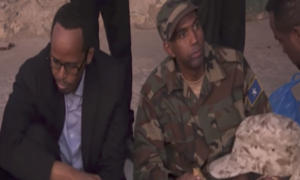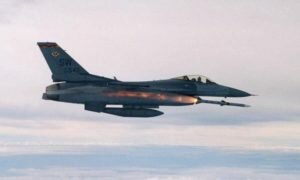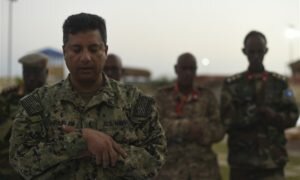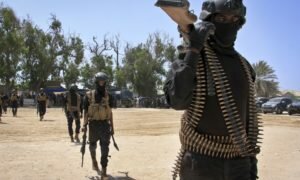![]() On Jan. 15, 2016, Shabaab, al Qaeda’s branch in Somalia, overran an AMISOM (African Union Mission in Somalia) base in the town of El Adde. At sunrise, two vehicle-borne improvised explosive devices (VBIEDs) cleared the way for hundreds of jihadists to stream into the base.
On Jan. 15, 2016, Shabaab, al Qaeda’s branch in Somalia, overran an AMISOM (African Union Mission in Somalia) base in the town of El Adde. At sunrise, two vehicle-borne improvised explosive devices (VBIEDs) cleared the way for hundreds of jihadists to stream into the base.
The Kenyan forces manning the facility were quickly outmatched. The United Nations later found that “150 Kenyan soldiers were killed during the attack, making it the largest military defeat in Kenyan history.”
Not all of the Kenyan soldiers were killed. At least 11 of them, according to the UN, “were captured alive and subsequently held hostage in two separate groups by” Shabaab in the Middle Juba region of southern Somalia.
One of those Kenyan soldiers, Alfred Danyi Kilasi (seen obove), appeared in a Shabaab video released online earlier today – more than 16 months after he was taken captive. The video, along with an English transcript, was produced by Al-Kataib Foundation for Media, Shabaab’s propaganda arm.
“My name is Senior Private Alfred Danyi Kilasi,” the Kenyan begins. “I was born in 1987 in Western Province, Vihiga County, Vigeena village. I joined the army on 10 October 2010 and after training, I was posted to Nenkea, Moi Barracks.”
“On the 15th of January last year,” Kilasi continues, “I remember vividly that while we were in El Adde, we were attacked by Al Shabaab. They infiltrated our camp and took over our defense posts. We lost our comrades and we were captured as prisoners.”
Shabaab has Kilasi criticize his own government and plead with the Kenyan people to intercede on his behalf.
“From that time up to now, we have been in captivity and have not received any report from our government,” Kilasi says, as the camera zooms in on a “Kenya” patch on his uniform. “We have not received any kind of assistance. We are pleading with the Kenyan public to come together and find a solution for this dilemma that we are faced with. Right now, we have no one else to help us except you.”
“I am pleading with the leaders in Kenya,” Kilasi adds. “Where are you? We are suffering here in Somalia and are in dire need of your assistance. This is an election year and so we are pleading that before you go for elections, look for any means in which you can save us for we are your brethren.”
Kilasi’s tragic appearance is the latest instance in which Shabaab has used the Jan. 2016 attack, and the aftermath, in its propaganda.
Shabaab said the raid was carried out by its Saleh Ali Nabhan Brigade, named after a notorious al Qaeda leader who was killed in 2009. Nabhan had been wanted for his role in the 1998 US Embassy bombings, as well as a series of plots in Mombasa, Kenya in 2002. The brigade has been responsible for some of Shabaab’s highest profile operations, including the July 2010 bombings in Kampala, Uganda.
The al Qaeda arm boasted of its spoils from the base in El Adde — including arms, ammunition and armored personnel carriers — in a photoset disseminated online just days afterward. [See FDD’s Long War Journal report, Shabaab releases photos from captured African Union base.]
Then, in Apr. 2016, Shabaab released a 48-minute video promoting the massacre as “The Sheikh Abu Yahya al Libi Raid.” Al Libi was a senior al Qaeda manager and popular ideologue when he was killed in a June 2012 drone strike in northern Pakistan.
The Kenyan government was accused throughout the international press of covering up the extent of its embarrassing defeat in El Adde. The UN found that Shabaab’s Apr. 2016 video “depicted a highly uncoordinated and tactically unsound assault on the part of” Shabaab, but the “Kenyan forces also failed to implement basic defensive measures, such as constructing fortified barriers at the entrance to the camp and neglecting to man machine gun and mortar emplacements.” Other intelligence failures were cited as well.
Shabaab doesn’t make any explicit demands in Kilasi’s video. But it is possible that the jihadists are attempting to extract concessions behind the scenes. The UN explained that its representatives have “received information concerning the changing whereabouts and status of the captives, which it has shared with the Kenyan authorities through an intermediary.”
“We are in the hands of Shabaab and we are not aware of what our fate will be,” Kilasi says. “We are begging you to help us in any way that you can.”
Even if Shabaab isn’t seeking an exchange, the group is all too happy to promote what the UN has described as the worst defeat for the Kenyan military in its history.




 Spectacularly punished by voters who took away her majority in Parliament, a politically wounded Theresa May sought Friday to soldier on as...
Spectacularly punished by voters who took away her majority in Parliament, a politically wounded Theresa May sought Friday to soldier on as...
























